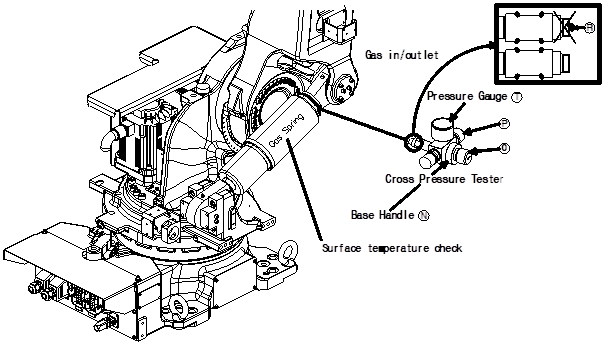9.3. Releasing the Gas of the Gas Spring
9.3. Releasing the Gas of the Gas Spring
You should release the gas of the gas spring in the following cases.
- When the gas spring needs to be separated from the robot, but the H axis cannot be operated, making it impossible to put the H axis at 90°.
- When required to transport the robot by air (The law restricts that air transport of machinery equipped with high-pressure equipment should be performed after depressurizing it.)
Caution
If the gas is rapidly released, colored oil inside the spring may be spurting out. You should wear protective glasses and carry out the releasing work slowly. |
(1) Remove the plug installed to the gas inlet of the gas spring.
(2) Check whether the handle of the bleed valve P is closed (clockwise.)
(3) Check whether the gas release pin of the part marked as R]is protruding. If it is protruding, turn the handle of the knob Ocounterclockwise to prevent the pin from protruding.
(4) Turn the knob Nof the pressure tester clockwise to completely connect it to the gas inlet
(5) Turn the knob Oclockwise and then stop turning it if the pointer of the pressure gauge Tmoves (To avoid making the release pin Rgo inside excessively and damage the valve inside the gas spring, do not turn the knob Ohandle excessively.)
(6) Turn the bleed valve Pcounterclockwise slowly to completely release the gas.
Warning! Never look directly into the gas outlet.
(7) Turn the knob Ocounterclockwise to retreat the release pin R. After that, turn the knob N of the pressure tester counterclockwise to separate it.
(8) Connect the G1/8 plug to the gas spring.

Figure 9.4 Releasing the Gas of the Gas Spring